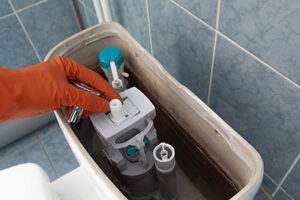
Common Reasons Your Toilet Is Running
- Faulty Flapper
The flapper is a rubber seal that sits at the bottom of the tank and controls water flow into the bowl. Over time, it can become worn or misaligned, leading to leaks. - Improper Chain Length
The chain connecting the flush handle to the flapper can sometimes be too long or too short, causing the flapper to stay partially open or fail to seal properly. - Malfunctioning Fill Valve
The fill valve controls the water level in the tank. If it’s not working correctly, the water level may rise too high and spill into the overflow tube. - Worn-Out Float
The float regulates the amount of water in the tank. If it’s damaged or misaligned, the tank may overfill, causing constant water flow. - Dirty or Damaged Flush Valve Seat
Mineral deposits or debris can build up around the flush valve seat, preventing the flapper from sealing properly.
Quick Fixes for a Running Toilet
- Check and Replace the Flapper
- Turn off the water supply to the toilet.
- Remove the tank lid and inspect the flapper for wear or damage.
- If it’s worn, purchase a replacement flapper at your local hardware store and install it according to the instructions.
- Adjust the Chain
- Make sure the chain has just enough slack to allow the flapper to close completely after flushing.
- If it’s too long, shorten it by adjusting the hook placement.
- Inspect and Adjust the Fill Valve
- Look for the water level in the tank. It should sit about 1 inch below the top of the overflow tube.
- If the water is too high, adjust the float by turning the screw on the fill valve or bending the float arm (in older models).
- Clean the Flush Valve Seat
- Turn off the water supply and drain the tank.
- Clean the flush valve seat with a sponge or scrubber to remove any debris or mineral buildup.
- Ensure the flapper creates a tight seal when closed.
- Replace the Fill Valve or Float
- If the fill valve or float is damaged, it may need to be replaced. These components are relatively inexpensive and available at most hardware stores.
- Follow the manufacturer’s instructions for installation.
When to Call a Professional Plumber
If you’ve tried these fixes and your toilet is still running, it might be time to call in a professional. Issues like cracks in the tank, problems with the plumbing system, or other underlying issues may require expert attention. A plumber can quickly diagnose and resolve the problem, saving you time and frustration.
Preventing Future Issues
- Regularly inspect your toilet for signs of wear or leaks.
- Avoid using harsh chemical cleaners in the tank, as they can damage rubber components.
- Schedule routine plumbing maintenance to catch potential problems early.
A running toilet doesn’t have to be a source of stress—or a drain on your wallet. By understanding the common causes and applying these quick fixes, you can often resolve the issue yourself. If all else fails, don’t hesitate to seek professional help to ensure your plumbing system stays in top shape.
Have a running toilet problem you can’t solve? Call us.
Elite Plumbing of Florida provides plumbing services in Clearwater, Palm Harbor, and Safety Harbor and most of Pinellas County.
For more information, visit our website https://eliteplumbingoffloridallc.com/or call (727) 301-4846.
